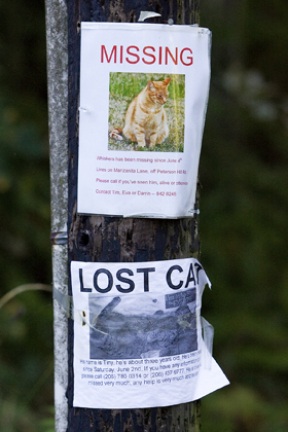Meadowmeer residents say their cats are falling prey to wild animals.
A resurgent coyote population has one island neighborhood fed up and appealing to the city for help.
Meadowmeer residents say problems began a year ago, and have reached the point where coyotes are now seen prowling during the day in search of food – usually in the form of family pets.
“There are ‘missing cat’ posters on every telephone pole and every stop sign, and there sure isn’t a cat napper on the loose,” said Astor Court resident Steve Kratz.
“Our neighbor just lost a cat,” he said. “The grisly remains and the collar were found by another neighbor down the hillside. Almost all of our neighbors have lost cats in our area, and that’s just the people I’ve talked to.”
Kratz, whose family lost their cat last spring, said coyotes bring further troubles such as howling at night, scavenging in backyards and the killing of native species like raccoons.
However, Meadowmeer residents are being kept awake not just by coyote calls – but by the attempts by neighbors to combat the problem with with firearms, which have become more brazen and worrisome.
“On multiple occasions we’ve been awaken in the night by gunshots,” Kratz said. “It appeared clear to us that people are trying to resolve the issue that way, but having all your neighbors armed and taking potshots in the night is not the right way to resolve things.”
Although not advised, it is legal to shoot coyotes on private property. Washington Department of Fish and Wildlife representative Stephanie Sparks said “there is an open hunting season on coyotes year round” because they do not have any natural predators.
The number of coyotes in Washington and the Bainbridge area are impossible to estimate. The Department of Fish and Wildlife does not keep track of non-native species they consider “invasive,” and groups like Kitsap Animal Rescue and Enforcement only deal with the animals second-hand.
“We get calls throughout the year in regards to missing cats in fear that coyotes have got them,” said Rance McEntyre, the chief of Kitsap Animal Rescue and Enforcement. “We don’t have any solid figures. There may be at a slight increase (in attacks) since there is a lot of construction in the area that is forcing them out of their habitats.”
McEntyre has repeated the same advice to many concerned Kitsap citizens over the years: “Make sure you know where your animals are. Don’t let them wander because there is no such thing as the neighborhood dog. They should be home where they’re safe.”
One island-based wildlife group is downplaying the role of coyotes in local pet disappearances and believe the animals carry an unfair stigma.
“I’m not going to say a coyote won’t take a cat, but so will owls, so will eagles, so will cars,” said Mike Pratt, director of wildlife services at the West Sound Wildlife Shelter. “Cats have a rough time out there, especially from the human-made things like poisons and cars.”
Pratt cited the importance of coyotes in nature, and said previous efforts to wipe out the population failed.
“There are a few coyotes on the island, but it’s not out of control, and they can play an extremely important role in managing deer and rabbit populations,” he said. “Even with people hating them and hunting them year round, they still survive because they are scared of people.”
Pratt said it only takes some noise to reinforce the fear of humans that usually keeps coyotes at bay, and that families should keep animals indoors and secure potential food sources such as garbage bins and pet food.
“If they do have a problem where a coyote is getting too close, give us a call and we’ll send someone out there and we’ll see if it’s a natural behavior, if something is attracting them,” Pratt said. “We’ll work with people so we don’t have to shoot them.”
To Kratz, who wrote a letter citing his concerns to the City Council this week, the issue is more pressing with young children in his neighborhood.
“All we need is some little toddler to get nipped by these things that hunt in packs, then you would have an absolute outrage followed by lawsuits,” he said “It would be bad enough to have them nicked, but then the overreaction would be dreadful, particularly because it is preventable.”
“It is a clear and present threat and remedial action needs to be taken. The county and police can’t do anything. Fish and Wildlife (Services) are overwhelmed and don’t have the resources.
“I would encourage the city council to consider that,” Kratz continued. “It’s serious, but we’re not past the point of no return.



